- DARS (gene)
-
Aspartyl-tRNA synthetase Identifiers Symbols DARS; DKFZp781B11202; MGC111579 External IDs OMIM: 603084 MGI: 2442544 HomoloGene: 1032 GeneCards: DARS Gene EC number 6.1.1.12 Gene Ontology Molecular function • nucleotide binding
• nucleic acid binding
• aminoacylase activity
• aspartate-tRNA ligase activity
• protein binding
• ATP binding
• ligase activityCellular component • soluble fraction
• nucleus
• cytoplasm
• cytosol
• plasma membrane
• nuclear membraneBiological process • translation
• tRNA aminoacylation for protein translation
• aspartyl-tRNA aminoacylation
• protein complex assembly
• gene expressionSources: Amigo / QuickGO RNA expression pattern 

More reference expression data Orthologs Species Human Mouse Entrez 1615 226414 Ensembl ENSG00000115866 ENSMUSG00000026356 UniProt P14868 Q3TF87 RefSeq (mRNA) NM_001349 NM_145507 RefSeq (protein) NP_001340 NP_663482 Location (UCSC) Chr 2:
136.66 – 136.74 MbChr 1:
130.26 – 130.31 MbPubMed search [1] [2] Aspartyl-tRNA synthetase, cytoplasmic is an enzyme that in humans is encoded by the DARS gene.[1][2]
Aspartyl-tRNA synthetase (DARS) is part of a multienzyme complex of aminoacyl-tRNA synthetases. Aspartyl-tRNA synthetase charges its cognate tRNA with aspartate during protein biosynthesis.[2]
See also
References
- ^ Jacobo-Molina A, Peterson R, Yang DC (Oct 1989). "cDNA sequence, predicted primary structure, and evolving amphiphilic helix of human aspartyl-tRNA synthetase". J Biol Chem 264 (28): 16608–12. PMID 2674137.
- ^ a b "Entrez Gene: DARS aspartyl-tRNA synthetase". http://www.ncbi.nlm.nih.gov/sites/entrez?Db=gene&Cmd=ShowDetailView&TermToSearch=1615.
Further reading
- Norcum MT (1991). "Structural analysis of the high molecular mass aminoacyl-tRNA synthetase complex. Effects of neutral salts and detergents.". J. Biol. Chem. 266 (23): 15398–405. PMID 1651330.
- Reed VS, Wastney ME, Yang DC (1995). "Mechanisms of the transfer of aminoacyl-tRNA from aminoacyl-tRNA synthetase to the elongation factor 1 alpha.". J. Biol. Chem. 269 (52): 32932–6. PMID 7806521.
- Maruyama K, Sugano S (1994). "Oligo-capping: a simple method to replace the cap structure of eukaryotic mRNAs with oligoribonucleotides.". Gene 138 (1–2): 171–4. doi:10.1016/0378-1119(94)90802-8. PMID 8125298.
- Escalante C, Yang DC (1993). "Expression of human aspartyl-tRNA synthetase in Escherichia coli. Functional analysis of the N-terminal putative amphiphilic helix". J. Biol. Chem. 268 (8): 6014–23. PMID 8449960.
- Suzuki Y, Yoshitomo-Nakagawa K, Maruyama K, et al. (1997). "Construction and characterization of a full length-enriched and a 5'-end-enriched cDNA library". Gene 200 (1–2): 149–56. doi:10.1016/S0378-1119(97)00411-3. PMID 9373149.
- Quevillon S, Robinson JC, Berthonneau E, et al. (1999). "Macromolecular assemblage of aminoacyl-tRNA synthetases: identification of protein-protein interactions and characterization of a core protein". J. Mol. Biol. 285 (1): 183–95. doi:10.1006/jmbi.1998.2316. PMID 9878398.
- Rho SB, Kim MJ, Lee JS, et al. (1999). "Genetic dissection of protein-protein interactions in multi-tRNA synthetase complex". Proc. Natl. Acad. Sci. U.S.A. 96 (8): 4488–93. doi:10.1073/pnas.96.8.4488. PMC 16359. PMID 10200289. http://www.pubmedcentral.nih.gov/articlerender.fcgi?tool=pmcentrez&artid=16359.
- Kang J, Kim T, Ko YG, et al. (2000). "Heat shock protein 90 mediates protein-protein interactions between human aminoacyl-tRNA synthetases". J. Biol. Chem. 275 (41): 31682–8. doi:10.1074/jbc.M909965199. PMID 10913161.
- Sang Lee J, Gyu Park S, Park H, et al. (2002). "Interaction network of human aminoacyl-tRNA synthetases and subunits of elongation factor 1 complex". Biochem. Biophys. Res. Commun. 291 (1): 158–64. doi:10.1006/bbrc.2002.6398. PMID 11829477.
- Strausberg RL, Feingold EA, Grouse LH, et al. (2003). "Generation and initial analysis of more than 15,000 full-length human and mouse cDNA sequences". Proc. Natl. Acad. Sci. U.S.A. 99 (26): 16899–903. doi:10.1073/pnas.242603899. PMC 139241. PMID 12477932. http://www.pubmedcentral.nih.gov/articlerender.fcgi?tool=pmcentrez&artid=139241.
- Cheong HK, Park JY, Kim EH, et al. (2004). "Structure of the N-terminal extension of human aspartyl-tRNA synthetase: implications for its biological function". Int. J. Biochem. Cell Biol. 35 (11): 1548–57. doi:10.1016/S1357-2725(03)00070-0. PMID 12824064.
- Bouwmeester T, Bauch A, Ruffner H, et al. (2004). "A physical and functional map of the human TNF-alpha/NF-kappa B signal transduction pathway". Nat. Cell Biol. 6 (2): 97–105. doi:10.1038/ncb1086. PMID 14743216.
- Gerhard DS, Wagner L, Feingold EA, et al. (2004). "The status, quality, and expansion of the NIH full-length cDNA project: the Mammalian Gene Collection (MGC)". Genome Res. 14 (10B): 2121–7. doi:10.1101/gr.2596504. PMC 528928. PMID 15489334. http://www.pubmedcentral.nih.gov/articlerender.fcgi?tool=pmcentrez&artid=528928.
- Bonnefond L, Fender A, Rudinger-Thirion J, et al. (2005). "Toward the full set of human mitochondrial aminoacyl-tRNA synthetases: characterization of AspRS and TyrRS". Biochemistry 44 (12): 4805–16. doi:10.1021/bi047527z. PMID 15779907.
- Rual JF, Venkatesan K, Hao T, et al. (2005). "Towards a proteome-scale map of the human protein-protein interaction network". Nature 437 (7062): 1173–8. doi:10.1038/nature04209. PMID 16189514.
- Tu LC, Yan X, Hood L, Lin B (2007). "Proteomics analysis of the interactome of N-myc downstream regulated gene 1 and its interactions with the androgen response program in prostate cancer cells". Mol. Cell Proteomics 6 (4): 575–88. doi:10.1074/mcp.M600249-MCP200. PMID 17220478.
Categories:- Human proteins
- Chromosome 2 gene stubs
Wikimedia Foundation. 2010.
